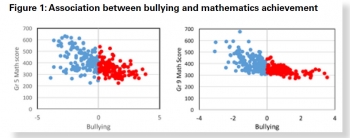Bullying - reduced when learners feel like they belong in a school
Research has found that creating a healthy social context within schools is vital for learner success. Are South African schools ensuring that the social needs of learners are met? Based on data from the 2015 Trends in International Mathematics and Science Study (TIMSS), Lolita Winnaar and Unathi Beku examine the association between academic achievement and bullying and investigate social factors linked to bullying in schools.
Many South African schools are characterised by high levels of bullying, safety concerns and disorderliness. An unsafe and disorderly schooling environment hinders the effectiveness of the learning environment. When the atmosphere in a school is one where learners feel like they belong, are constantly engaged and feel safe, learners are less likely to be victims of bullying, which is linked to better academic results. Bullying involves harmful or aggressive behaviour with the intention to harm an individual who is less dominant physically or emotionally.
Creating a caring and supportive social environment within schools is essential for the academic, social and emotional development of learners.
It is directly linked to school climate, which is a multi-dimensional concept that measures the health of the educational system. School safety, a sense of belonging and an engaging learning environment are key components of school climate that describes the intangible elements of the school environment.
Policies for safer schools?
The national Department of Basic Education (DBE) recognises that violence is a major contributing factor hampering effective schooling. This is evident in three key policy initiatives namely, the National School Safety Framework (NSSF) which aims to create a safe and engaged schooling climate (environment) for learners and teachers. It sets out a framework for collaboration and partnerships amongst schools, governing bodies and provincial administration. The DBE-South African Police Service (DBE-SAPS) protocol as well as the Prevention and Management of Bullying Programme sets out the framework for close co-ordination between the two departments. This is to create a safe and engaging learning environment, in which quality learning and teaching can take place. Finally, the Prevention and Management of Bullying Programme is a guiding document for collaboration between the provincial administration and schools.
The DBE prioritises a partnership and collaborative approach to addressing bullying and other school climate issues recognising that schools do not operate in silos, but are part of and influenced by broader communities.
Findings from our research
The 2015 Trends in International Mathematics and Science Study (TIMSS) provides us with the opportunity to examine, the association between academic achievement and bullying at the grade 5 and grade 9 levels.
Academic achievement and bullying
The bullying index was calculated to include learners’ responses to nine statements linked to aspects of bullying (see Table 1) and ranged from learners exposed to some form of bullying on a weekly basis to learners almost never being bullied. The data shows that 44% and 25% of learners in grade 5 and grade 9 respectively, experience at least one incidence of bullying weekly.
Figure 1 also shows strong associations between mathematics achievement and incidences of bullying in schools. Mathematics scores are lower for learners who are bullied more often. Not only do higher occurrences of bullying occur at the grade 5 level but the score difference between learners experiencing higher levels of bullying is also higher at the grade 5 level (53 points) than the grade 9 level (35 points).
Reducing bullying
Results from a regression analysis shows that boys are more often exposed to bullying than girls. However, more importantly, the social context within a school is strongly associated with incidences of bullying.
Social factors included discipline problems, safety and orderliness, learner engagement and learner sense of belonging.
Learner sense of belonging and engagement showed to be the highest predictors of bullying in schools. Learners who felt like they belonged in the school and were constantly engaged within the classroom were less likely to be bullied. This is true at the grade 5 and grade 9 levels.
Learner sense of belonging is the extent to which learners feel accepted and valued by their peers and teachers. If learners feel like they belong, they are more engaged in the classroom and feel less alienated. The latter can make them targets for bullying.
What can schools do?
Effective schools have an environment where learners feel safe, are constantly engaged and feel like they belong. Access to quality physical resources are important to the functionality of a school, however it goes beyond resources. To reduce the achievement gap between learners who have experienced bullying and those who have not, we need to be cognisant of school social factors.
In response to the increased levels of bullying and violence occurring in schools, the DBE has established policies and partnerships with the SAPS to monitor violence in schools. These initiatives are important, however, it is a reactive approach. We need a proactive approach that involves closer relationships between staff members of a school, the community and parents to address concerns about school climate. We should make concerted efforts to understand how the organisational and professional conditions of a school can support learning. This includes addressing issues of management and leadership, placing more emphasis on academic success, ensuring the safety of learners and addressing ill-discipline. The challenges that teachers face should also be reduced and teacher job satisfaction made a priority. Such a holistic approach to addressing school climate concerns will assist in reducing and possibly eradicating bullying in schools.
Authors: Lolita Winnaar, a senior research manager, and Unathi Beku, a master’s intern in the HSRC’s Education and Skills Development research programme
lwinnaar@hsrc.ac.za
ubeku@hsrc.ac.za


